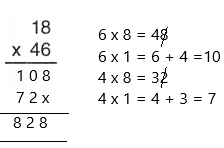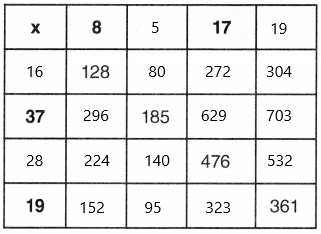By accessing our 180 Days of Math for Fifth Grade Answers Key Day 156 regularly, students can get better problem-solving skills.
180 Days of Math for Fifth Grade Answers Key Day 156
Directions: Solve each problem.
Question 1.
Take 38 away from 179.
Answer:
Subtraction is one of the four basic arithmetic operations in mathematics. We can observe the applications of subtraction in our everyday life in different situations. For example, when we purchase fruits and vegetables for a certain amount of money say Rs. 200 and we have been given Rs. 500 note to the vendor. Now, the vendor returns the excess amount by performing subtraction such as 500 – 200 = 300. Then, the vendor will return Rs. 300.
Now we need to calculate the above-given question:

179 = Minuend; 38 = Subtrahend; 141 = Difference
Therefore, the answer is 141.
Question 2.

Answer:
In mathematics, multiplication is a method of finding the product of two or more numbers. It is one of the basic arithmetic operations, that we use in everyday life. The major application we can see in multiplication tables.
In arithmetic, the multiplication of two numbers represents the repeated addition of one number with respect to another. These numbers can be whole numbers, natural numbers, integers, fractions, etc. If m is multiplied by n, then it means either m is added to itself ‘n’ a number of times or vice versa.
The formula for multiplication:
The multiplication formula is given by:
Multiplier × Multiplicand = Product
– The multiplicand is the total number of objects in each group
– A multiplier is the number of equal groups
– Product is the result of multiplication of multiplier and multiplicand

Therefore, the answer is 828.
Question 3.
![]()
Answer:
The square root of a number is defined as the value, which gives the number when it is multiplied by itself. The radical symbol √ is used to indicate the square root. For example, √9 = 3. The radical symbol is also called a root symbol or surds. If a number is a perfect square, we can easily find the square root of the number. If the given number is not a perfect square number, the square root can be found using the long division method.
– Here we will show you how to calculate the square root of 528 using the long division method with one decimal place accuracy.
–therefore, the square root of 528 is 22.978
The above-given question is 36 square roots of 528 is:
Now multiply 36 by 22.978
Thus, 36*22.978 is 827.208
Question 4.
What is the last even number before 60,000?
Answer:
Any number that can be exactly divided by 2 is called an even number. Even numbers always end up with the last digit as 0, 2, 4, 6 or 8. Some examples of even numbers are 2, 4, 6, 8, 10, 12, 14, and 16. These are even numbers as these numbers can easily be divided by 2. It should be noted that the smallest positive even natural number is 2
The last even number before 60,000 is 59998
59998 is divisible by 2 which is the last even number before 60,000.
Question 5.
50% of $40 is ___________
Answer:
a percentage is a number or ratio that can be expressed as a fraction of 100. If we have to calculate per cent of a number, divide the number by the whole and multiply by 100. Hence, the percentage means, a part per hundred. The word per cent means per 100. It is represented by the symbol “%”.
To determine the percentage, we have to divide the value by the total value and then multiply the resultant to 100.
Percentage formula = (Value/Total value)×100
50/100 x 40 = X
1/2 x 40 = X
20 = X
therefore, 20% is the answer.
Question 6.
50 ÷ 2 + 30 = ![]()
Answer:
Let the empty box be X
The value of 50 ÷ 2 is 25
now add the value we got with the 30.
X = 25 + 30
X = 55
Therefore, the answer for the above equation is 55.
Question 7.
![]() ÷ 8 = 20
÷ 8 = 20
Answer:
Let the empty box be P
P ÷ 8 = 20
Now get the 8 to the right-hand side then the equation will be:
P = 20 x 8
P = 160
Now substitute P-value in the above equation.
P ÷ 8 = 20
160 ÷ 8 = 20
20 = 20
LHS =RHS
hence, the answer is verified.
Question 8.
How many minutes are there from 19 to 7 until 17 past 7?
Answer:
To calculate the difference in hours and minutes between two given times. To calculate the hours and minutes contained in a time period you need to know its beginning and end.
The difference between 19 to 7 and 17 past 7:
the difference is 22 hours
the difference in minutes: 1,320
Question 9.
Are the angles on a regular pentagon acute, right, or obtuse?
Answer:
The angles of a pentagon include acute, right and obtuse angles. A pentagon can have at most three right angles. If there are three right angles, then the other two angles will be obtuse angles. All five angles can be obtuse but all angles cannot be right angles or obtuse angles. (or)
A pentagon has 540 degrees and five sides. If it is a regular pentagon, then each angle is 108 degrees. An obtuse angle is greater than 90°. A pentagon can be constructed with 2 obtuse angles and 3 non-obtuse it may be either acute or right angles.
Question 10.
Gary has 23 quarters. He wants to buy a music CD that costs $13.95. He saves 4 quarters every week. Will he have enough quarters in 4 weeks to buy the CD?

Answer:
The number of quarters Gary has = 23
The amount he put into buying a CD = $13.95
The number of quarters he saves every week=4
starting has 23 quarters and every week he is saving 4 quarters.
The quarters are shown in the above diagram.
A CD costs $13.95. In week 4, he has 39 quarters. Yes, definitely he would have enough quarters.
Question 11.
You have a bag of 12 marbles. Six of the marbles are blue, two are green, three are yellow, and one is red. If you reach into the bag and grab one marble, what is the probability that it will be red or blue?
Answer:
Probability can be defined as the ratio of the number of favourable outcomes to the total number of outcomes of an event. For an experiment having ‘n’ number of outcomes, the number of favourable outcomes can be denoted by x. The formula to calculate the probability of an event is as follows.
Probability(Event) = Favorable Outcomes/Total Outcomes = x/n
The total number of marbles=12
the number of blue marbles=6
The number of green marbles=2
the number of yellow marbles=3
The number of red marbles=1
P(red)=1/12
P(blue)=6/12=1/2
P(red or blue) = 1/12 + 1/2
P(red or blue) 1+6/12
P(red or blue)=7/12
Question 12.
Complete the multiplication table.

Answer:
In the last row 19 and 361 are given.
19 x M = 361
M=361/19
M=19; so I kept 19 in the first row; last box.
And 17 is given in the first row so multiply 19 x 17 = 323. Likewise, we need to fill all the columns and rows.
16 x 8 = 128; 16 x 5 = 80; 16 x 17 = 271; 16 x 19 = 304
37 x 8 = 296; 37 x 5 = 185; 37 x 17 = 629; 37 x 19 = 703
28 x 8 = 224; 28 x 5 = 140; 28 x 17 = 476; 28 x 19 = 532
19 x 8 = 152; 19 x 5 = 95; 19 x 17 = 323; 19 x 19 = 361.
